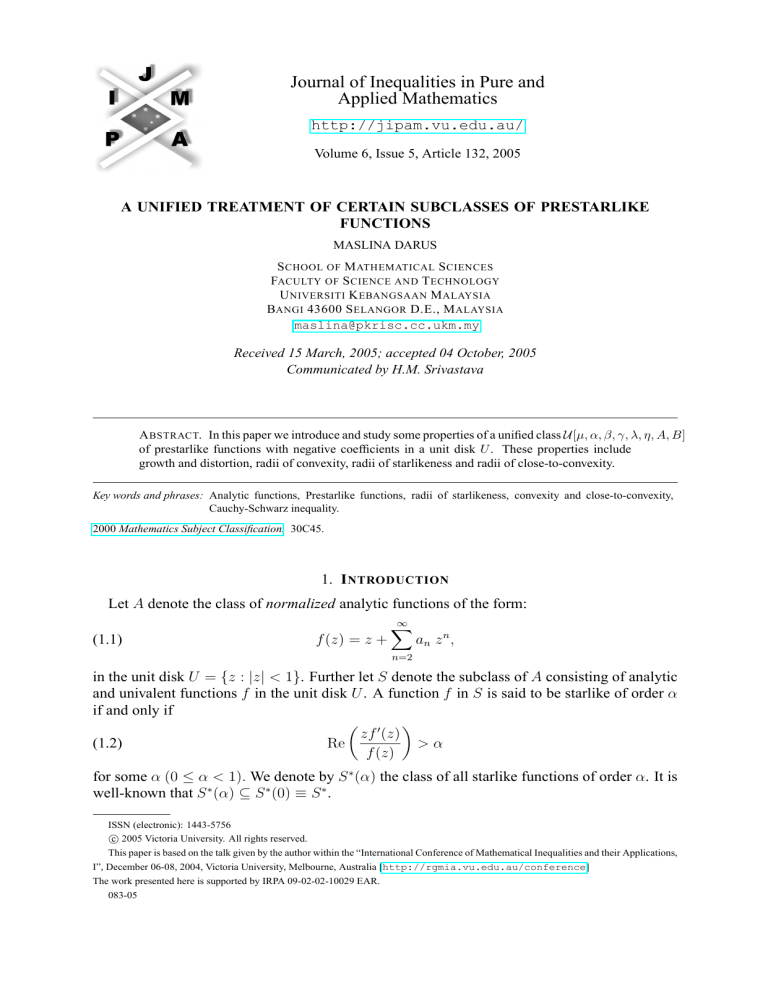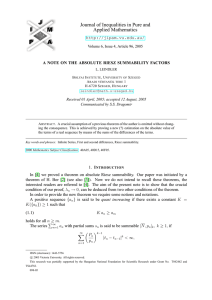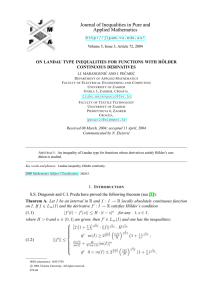
Journal of Inequalities in Pure and
Applied Mathematics
http://jipam.vu.edu.au/
Volume 6, Issue 5, Article 132, 2005
A UNIFIED TREATMENT OF CERTAIN SUBCLASSES OF PRESTARLIKE
FUNCTIONS
MASLINA DARUS
S CHOOL OF M ATHEMATICAL S CIENCES
FACULTY OF S CIENCE AND T ECHNOLOGY
U NIVERSITI K EBANGSAAN M ALAYSIA
BANGI 43600 S ELANGOR D.E., M ALAYSIA
maslina@pkrisc.cc.ukm.my
Received 15 March, 2005; accepted 04 October, 2005
Communicated by H.M. Srivastava
A BSTRACT. In this paper we introduce and study some properties of a unified class U[µ, α, β, γ, λ, η, A, B]
of prestarlike functions with negative coefficients in a unit disk U . These properties include
growth and distortion, radii of convexity, radii of starlikeness and radii of close-to-convexity.
Key words and phrases: Analytic functions, Prestarlike functions, radii of starlikeness, convexity and close-to-convexity,
Cauchy-Schwarz inequality.
2000 Mathematics Subject Classification. 30C45.
1. I NTRODUCTION
Let A denote the class of normalized analytic functions of the form:
(1.1)
f (z) = z +
∞
X
an z n ,
n=2
in the unit disk U = {z : |z| < 1}. Further let S denote the subclass of A consisting of analytic
and univalent functions f in the unit disk U . A function f in S is said to be starlike of order α
if and only if
0 zf (z)
(1.2)
Re
>α
f (z)
for some α (0 ≤ α < 1). We denote by S ∗ (α) the class of all starlike functions of order α. It is
well-known that S ∗ (α) ⊆ S ∗ (0) ≡ S ∗ .
ISSN (electronic): 1443-5756
c 2005 Victoria University. All rights reserved.
This paper is based on the talk given by the author within the “International Conference of Mathematical Inequalities and their Applications,
I”, December 06-08, 2004, Victoria University, Melbourne, Australia [http://rgmia.vu.edu.au/conference]
The work presented here is supported by IRPA 09-02-02-10029 EAR.
083-05
2
M ASLINA DARUS
Let the function
(1.3)
Sα (z) =
z
,
(1 − z)2(1−α)
(z ∈ U ;
0 ≤ α < 1)
which is the extremal function for the class S ∗ (α). We also note that Sα (z) can be written in the
form:
∞
X
(1.4)
Sα (z) = z +
|cn (α)|z n ,
n=2
where
(1.5)
cn (α) =
Πnj=2 (j − 2α)
(n − 1)!
(n ∈ N {1}, N := {1, 2, 3, . . .}).
We note that cn (α) is decreasing in α and satisfies
∞ if α < 12 ,
(1.6)
lim cn (α) = 1
if α = 12 ,
n→∞
0
if α > 12 .
Also a function f in S is said to be convex of order α if and only if
zf 00 (z)
(1.7)
Re 1 + 0
>α
f (z)
for some α (0 ≤ α < 1). We denote by K(α) the class of all convex functions of order α. It is
a fact that f ∈ K(α) if and only if zf 0 (z) ∈ S ∗ (α).
The well-known Hadamard
(or convolution) of two functions f (z) given by (1.1) and
P∞product
n
g(z) given by g(z) = z + n=2 bn z is defined by
(1.8)
(f ∗ g)(z) = z +
∞
X
an b n z n ,
(z ∈ U ).
n=2
Let R[µ, α, β, γ, λ, A, B] denote the class of prestarlike functions satisfying the following
condition
zHλ0 (z)
Hλ (z)
(1.9)
2γ(B − A)
zHλ0 (z)
Hλ (z)
−1
0
< β,
zH (z)
− µ − B Hλλ(z) − 1
where Hλ (z) = (1 − λ)h(z) + λzh0 (z), λ ≥ 0, h = f ∗ Sα , 0 < β ≤ 1, 0 ≤ µ < 1, and
( B
, µ 6= 0,
B
2(B−A)µ
<γ≤
2(B − A)
1,
µ=0
for fixed −1 ≤ A ≤ B ≤ 1 and 0 < B ≤ 1.
We also note that a function f is a so-called α-prestarlike (0 ≤ α < 1) function if, and only if,
h = f ∗ Sα ∈ S ∗ (α) which was first introduced by Ruscheweyh [3], and was rigorously studied
by Silverman and Silvia [4], Owa and Ahuja [5] and Uralegaddi and Sarangi [6]. Further, a function f ∈ A is in the class C[µ, α, β, γ, λ, A, B] if and only if, zf 0 (z) ∈ R[µ, α, β, γ, λ, A, B].
Let T denote the subclass of A consisting of functions of the form
∞
X
(1.10)
f (z) = z −
an z n , (an ≥ 0).
n=2
J. Inequal. Pure and Appl. Math., 6(5) Art. 132, 2005
http://jipam.vu.edu.au/
A U NIFIED P RESENTATION OF P RESTARLIKE F UNCTIONS
3
Let us write
RT [µ, α, β, γ, λ, A, B] = R[µ, α, β, γ, λ, A, B] ∩ T
and
CT [µ, α, β, γ, λ, A, B] = C[µ, α, β, γ, λ, A, B] ∩ T
where T is the class of functions of the form (1.10) that are analytic and univalent in U . The idea
of unifying the study of classes RT [µ, α, β, γ, λ, A, B] and CT [µ, α, β, γ, λ, A, B] thus, forming
a new class U[µ, α, β, γ, λ, η, A, B] is somewhat or rather motivated from the work of [1] and
[2].
In this paper, we will study the unified presentation of prestarlike functions belonging to
U[µ, α, β, γ, λ, η, A, B] which include growth and distortion theorem, radii of convexity, radii
of starlikeness and radii of close-to-convexity.
2. C OEFFICIENT I NEQUALITY
Our main tool in this paper is the following result, which can be easily proven, and the details
are omitted.
Lemma 2.1. Let the function f be defined by (1.10). Then f ∈ RT [µ, α, β, γ, λ, A, B] if and
only if
(2.1)
∞
X
Λ(n, λ)D[n, β, γ, A, B]|an |cn (α) ≤ E[β, γ, µ, A, B]
n=2
where
Λ(n, λ) = (1 + (n − 1)λ),
D[n, β, γ, A, B] = n − 1 + 2βγ(n − µ)(B − A) − Bβ(n − 1),
E[β, γ, µ, A, B] = 2βγ(1 − µ)(B − A).
The result is sharp.
Next, by observing that
(2.2)
f ∈ CT [µ, α, β, γ, λ, A, B] ⇔ zf 0 (z) ∈ RT [µ, α, β, γ, λ, A, B],
we gain the following Lemma 2.2.
Lemma 2.2. Let the function f be defined by (1.10). Then f ∈ CT [µ, α, β, γ, λ, A, B] if and
only if
(2.3)
∞
X
nΛ(n, λ)D[n, β, γ, A, B]|an |cn (α) ≤ E[β, γ, µ, A, B]
n=2
where
Λ(n, λ) = (1 + (n − 1)λ),
D[n, β, γ, A, B] = n − 1 + 2βγ(n − µ)(B − A) − Bβ(n − 1),
E[β, γ, µ, A, B] = 2βγ(1 − µ)(B − A)
and cn (α) given by (1.5).
J. Inequal. Pure and Appl. Math., 6(5) Art. 132, 2005
http://jipam.vu.edu.au/
4
M ASLINA DARUS
In view of Lemma 2.1 and Lemma 2.2, we unified the classes RT [µ, α, β, γ, λ, A, B] and
CT [µ, α, β, γ, λ, A, B] and so a new class U[µ, α, β, γ, λ, η, A, B] is formed. Thus we say that a
function f defined by (1.10) belongs to U[µ, α, β, γ, λ, η, A, B] if and only if,
∞
X
(2.4)
(1 − η + nη)Λ(n, λ)D[n, β, γ, A, B]|an |cn (α) ≤ E[β, γ, µ, A, B],
n=2
(0 ≤ α < 1; 0 < β ≤ 1; η ≥ 0; λ ≥ 0; −1 ≤ A ≤ B ≤ 1 and 0 < B ≤ 1),
where Λ(n, λ), D[n, β, γ, A, B] , E[β, γ, µ, A, B] and cn (α) are given in (Lemma 2.1 and
Lemma 2.2) and given by (1.5), respectively.
Clearly, we obtain
U[µ, α, β, γ, λ, η, A, B] = (1 − η)RT [µ, α, β, γ, A, B] + ηCT [µ, α, β, γ, A, B],
so that
U[µ, α, β, γ, λ, 0, A, B] = RT [µ, α, β, γ, A, B],
and
U[µ, α, β, γ, λ, 1, A, B] = CT [µ, α, β, γ, A, B].
3. G ROWTH
AND
D ISTORTION T HEOREM
A distortion property for function f in the class U[µ, α, β, γ, λ, η, A, B] is given as follows:
Theorem 3.1. Let the function f defined by (1.10) be in the class U[µ, α, β, γ, λ, η, A, B], then
(3.1) r −
E[β, γ, µ, A, B]
r2
2(1 + η)Λ(2, λ)D[2, β, γ, A, B](1 − α)
≤ |f (z)| ≤ r +
(η ≥ 0;
0 ≤ α < 1;
E[β, γ, µ, A, B]
r2 ,
2(1 + η)Λ(2, λ)D[2, β, γ, A, B](1 − α)
0 < β ≤ 1;
z ∈ U)
and
(3.2) 1 −
E[β, γ, µ, A, B]
r
(1 + η)Λ(2, λ)D[2, β, γ, A, B](1 − α)
≤ |f 0 (z)| ≤ 1 +
(η ≥ 0;
0 ≤ α < 1;
E[β, γ, µ, A, B]
r,
(1 + η)Λ(2, λ)D[2, β, γ, A, B](1 − α)
0 < β ≤ 1;
z ∈ U ).
The bounds in (3.1) and (3.2) are attained for the function f given by
f (z) = z −
E[β, γ, µ, A, B]
z2.
2(1 + η)Λ(2, λ)D[2, β, γ, A, B](1 − α)
Proof. Observing that cn (α) defined by (1.5) is nondecreasing for (0 ≤ α < 1), we find from
(2.4) that
(3.3)
∞
X
n=2
|an | ≤
E[β, γ, µ, A, B]
.
2(1 + η)Λ(2, λ)D[2, β, γ, A, B](1 − α)
J. Inequal. Pure and Appl. Math., 6(5) Art. 132, 2005
http://jipam.vu.edu.au/
A U NIFIED P RESENTATION OF P RESTARLIKE F UNCTIONS
5
Using (1.10) and (3.3), we readily have (z ∈ U )
|f (z)| ≥ |z| −
∞
X
|an |cn (α)|z n |
n=2
2
≥ |z| − |z |
∞
X
|an |cn (α),
n=2
E[β, γ, µ, A, B]
r2 ,
2(1 + η)Λ(2, λ)D[2, β, γ, A, B](1 − α)
≥r−
|z| = r < 1
and
∞
X
|f (z)| ≤ |z| +
|an |cn (α)|z n |
n=2
2
≤ |z| + |z |
∞
X
|an |cn (α),
n=2
E[β, γ, µ, A, B]
r2 ,
2(1 + η)Λ(2, λ)D[2, β, γ, A, B](1 − α)
which proves the assertion (3.1) of Theorem 3.1.
Also, from (1.10), we find for z ∈ U that
∞
X
0
|f (z)| ≥ 1 −
n|an |cn (α)|z n−1 |
≤r+
|z| = r < 1,
n=2
≥ 1 − |z|
∞
X
n|an |cn (α),
n=2
≥1−
E[β, γ, µ, A, B]
r,
(1 + η)Λ(2, λ)D[2, β, γ, A, B](1 − α)
|z| = r < 1
and
0
|f (z)| ≤ 1 +
∞
X
n|an |cn (α)|z n−1 |
n=2
≤ 1 + |z|
∞
X
n|an |cn (α),
n=2
E[β, γ, µ, A, B]
r,
2(1 + η)Λ(2, λ)D[2, β, γ, A, B](1 − α)
which proves the assertion (3.2) of Theorem 3.1.
≤1+
|z| = r < 1,
4. R ADII C ONVEXITY AND S TARLIKENESS
The radii of convexity for class U[µ, α, β, γ, λ, η, A, B] is given by the following theorem.
Theorem 4.1. Let the function f be in the class U[µ, α, β, γ, λ, η, A, B]. Then the function f is
convex of order ρ (0 ≤ ρ < 1) in the disk |z| < r1 (µ, α, β, γ, λ, η, A, B) = r1 , where
1
2(1 − α)(1 − ρ)Λ(n, λ)D[n, β, γ, A, B](1 − η + nη) n−1
(4.1)
r1 = inf
.
n
n(n − ρ)E[β, γ, µ, A, B]
J. Inequal. Pure and Appl. Math., 6(5) Art. 132, 2005
http://jipam.vu.edu.au/
6
M ASLINA DARUS
Proof. It sufficient to show that
(4.2)
P
− ∞
n(n − 1)an z n−1
zf 00 (z)
n=2
P
=
n−1
f 0 (z)
1− ∞
n=2 nan z
P∞
n(n − 1)an |z|n−1
≤ n=2P∞
1 − n=2 nan |z|1−n
which implies that
P∞
− 1)|an ||z|n−1
zf 00 (z)
n=2 n(n
P
(1 − ρ) −
≥
(1
−
ρ)
−
n−1
f 0 (z)
1− ∞
n=2 nan z
P∞
(1 − ρ) − n=2 n(n − ρ)an |z|n−1
P
(4.3)
=
.
n−1
1− ∞
n=2 nan |z|
Hence from (4.1), if
(1 − ρ) 2(1 − α)Λ(n, λ)D[n, β, γ, A, B](1 − η + nη)
(4.4)
|z|n−1 ≤
·
,
n(n − ρ)
E[β, γ, µ, A, B]
and according to (2.4)
∞
X
(4.5)
1−ρ−
n(n − ρ)an |z|n−1 > 1 − ρ − (1 − ρ) = ρ.
n=2
Hence from (4.3), we obtain
zf 00 (z)
<1−ρ
f 0 (z)
Therefore
zf 00 (z)
Re 1 + 0
> 0,
f (z)
which shows that f is convex in the disk |z| < r1 (µ, α, β, γ, λ, η, ρ, A, B).
By setting η = 0 and η = 1, we have the Corollary 4.2 and the Corollary 4.3, respectively.
Corollary 4.2. Let the function f be in the class RT (µ, α, β, γ, λ, ρ, A, B). Then the function
f is convex of order ρ (0 ≤ ρ < 1) in the disk |z| < r2 (µ, α, β, γ, λ, ρ, A, B) = r2 , where
1
2(1 − α)(1 − ρ)Λ(n, λ)D[n, β, γ, A, B] n−1
(4.6)
r2 = inf
.
n
n(n − ρ)E[β, γ, µ, A, B]
Corollary 4.3. Let the function f be in the class CT (µ, α, β, γ, λ, ρ, A, B). Then the function f
is convex of order ρ (0 ≤ ρ < 1) in the disk |z| < r3 (µ, α, β, γ, λ, ρ, A, B) = r3 , where
1
2(1 − α)(1 − ρ)Λ(n, λ)D[n, β, γ, A, B] n−1
.
(4.7)
r3 = inf
n
(n − ρ)E[β, γ, µ, A, B]
Theorem 4.4. Let the function f be in the class U[µ, α, β, γ, λ, η, A, B]. Then the function f is
starlike of order ρ (0 ≤ ρ < 1) in the disk |z| < r4 (µ, α, β, γ, λ, η, A, B) = r4 , where
1
2(1 − α)(1 − ρ)Λ(n, λ)D[n, β, γ, A, B](1 − η + nη) n−1
(4.8)
r4 = inf
.
n
(n − ρ)E[β, γ, µ, A, B]
Proof. It sufficient to show that
zf 0 (z)
−1 <1−ρ
f (z)
Using a similar method to Theorem 4.1 and making use of (2.4), we get (4.8).
J. Inequal. Pure and Appl. Math., 6(5) Art. 132, 2005
http://jipam.vu.edu.au/
A U NIFIED P RESENTATION OF P RESTARLIKE F UNCTIONS
7
Letting η = 0 and η = 1, we have the Corollary 4.5 and the Corollary 4.6, respectively.
Corollary 4.5. Let the function f be in the class RT (µ, α, β, γ, λ, ρ, A, B). Then the function
f is starlike of order ρ (0 ≤ ρ < 1) in the disk |z| < r5 (µ, α, β, γ, λ, ρ, A, B) = r5 , where
1
2(1 − α)(1 − ρ)Λ(n, λ)D[n, β, γ, A, B] n−1
(4.9)
r5 = inf
.
n
(n − ρ)E[β, γ, µ, A, B]
Corollary 4.6. Let the function f be in the class CT (µ, α, β, γ, λ, ρ, A, B). Then the function f
is starlike of order ρ (0 ≤ ρ < 1) in the disk |z| < r6 (µ, α, β, γ, λ, ρ, A, B) = r6 , where
1
2n(1 − α)(1 − ρ)Λ(n, λ)D[n, β, γ, A, B] n−1
.
(4.10)
r6 = inf
n
(n − ρ)E[β, γ, µ, A, B]
Last, but not least we give the following result.
Theorem 4.7. Let the function f be in the class U[µ, α, β, γ, λ, η, A, B]. Then the function f is
close-to-convex of order ρ (0 ≤ ρ < 1) in the disk |z| < r7 (µ, α, β, γ, λ, η, A, B) = r7 , where
1
2(1 − α)(1 − ρ)Λ(n, λ)D[n, β, γ, A, B](1 − η + nη) n−1
(4.11)
r7 = inf
.
n
nE[β, γ, µ, A, B]
Proof. It sufficient to show that
|f 0 (z) − 1| < 1 − ρ.
Using a similar technique to Theorem 4.1 and making use of (2.4), we get (4.11).
R EFERENCES
[1] H.M. SRIVASTAVA, H.M. HOSSEN AND M.K. AOUF, A unified presentation of some classes
meromorphically multivalent functions, Computers Math. Applic., 38 (1999), 63–70.
[2] R.K. RAINA AND H.M. SRIVASTAVA, A unified presentation of certain subclasses of prestarlike
functions with negative functions, Computers Math. Applic., 38 (1999), 71–78.
[3] S. RUSCHEWEYH, Linear operator between classes of prestarlike functions, Comm. Math. Helv.,
52 (1977), 497–509.
[4] H. SILVERMAN AND E.M. SILVIA, Prestarlike functions with negative coefficients, Internat. J.
Math. Math. Sci., 2 (1979), 427–439.
[5] S. OWA AND O.P. AHUJA, An application of the fractional calculus, Math. Japon., 30 (1985), 947–
955.
[6] B.A. URALEGADDI AND S.M. SARANGI, Certain generalization of prestarlike functions with
negative coefficients, Ganita, 34 (1983), 99–105.
J. Inequal. Pure and Appl. Math., 6(5) Art. 132, 2005
http://jipam.vu.edu.au/









